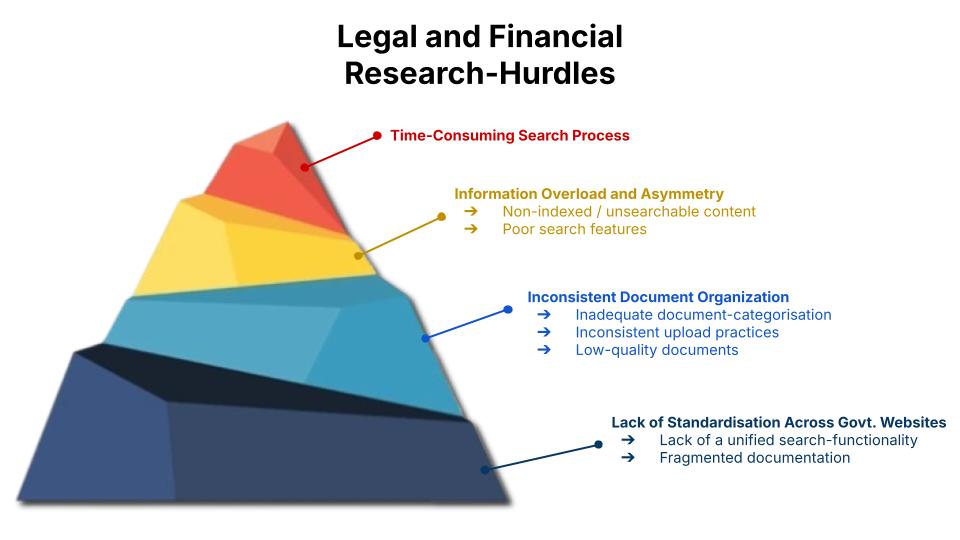AI, Can you Find My Circular (FMyC)?
‘As a corporate lawyer, locating relevant subordinate legislation is a lengthy process, often taking hours or even days. Even after spending this time, there is still uncertainty about the accuracy of the analysis as crucial documents may be misclassified, making the search less effective.’
- A quote from an interview with a senior legal expert
Undertaking legal research using public search platforms in India is quite challenging and cumbersome. Owing to fragmented documentation, overwhelming data, and inconsistent categorisation on government websites, legal professionals and the general public often struggle to access relevant documents and information.
This challenge is especially relevant for subordinate legislation i.e., laws other than as enacted by the legislature (parliament or state legislative assembly), given they are dispersed across websites of various government entities and are less consolidated than primary legislation. These concerns may be addressed with knowledge graphs, which typically map relationships between documents, updates, and amendments. Hence, they enable intuitive and efficient access to legal data.
We propose an AI-powered knowledge graph to simplify the search for documents across government entities, including regulators like the Reserve Bank of India (RBI) and the Securities and Exchange Board of India (SEBI), among others.
By delivering precise, context-aware answers, this AI tool can streamline accessibility and reduce the complexity of legal research. Ultimately, this would enable better decision-making for all stakeholders and serve public good by making crucial information more readily available.
What this blog contains
This blog covers the intricacies of how AI and knowledge graphs may transform the current legal and financial research landscape. We’ll take you through the various challenges, technical approaches, and the ultimate benefits of this innovative solution.
Drowning in Data (or the Lack Thereof) – Current Landscape for Legal and Financial Research
What is Subordinate Legislation, and What’s a Knowledge Graph?
The Mechanics of Building Connections in Data
Optimising Legal Research with AI and Knowledge Graphs
Drowning in data (or the lack thereof) – Current landscape for legal and financial research

Through conversations with legal professionals, including corporate lawyers, and advocates practising in High Courts across the country, we gained insights into numerous challenges they face regarding legal research and easily locating applicable laws (including enactments, and primarily, Subordinate legislations such as circulars and notifications).
These discussions have enabled us to identify key issues and thoroughly analyse their concerns. Aniket Raj, a legal professional notes:
“As a lawyer frequently navigating regulators’ websites such as RBI and SEBI, I find the process of searching for circulars and bylaws time-consuming and inefficient. The lack of a unified search interface and poor categorization of documents adds unnecessary complexity. A streamlined, user-friendly portal with advanced filtering options and better document tagging would greatly enhance accessibility. Moreover, integrating an AI-powered search function that can recognize key terms and provide predictive suggestions could further reduce the time spent on legal research.”
- Aniket Raj, Legal Professional
Information overload and complex user interfaces on Indian regulator’s websites pose significant challenges for citizens seeking to access relevant laws, including those set out in circulars and notifications. Despite the Government of India’s efforts to enhance online services through over 8,000 government websites, the lack of standardisation in design, navigation, and functionality creates confusion and inconvenience for users.
Additionally, while the government has introduced the ‘India Code’ as a central digital repository of laws, its reliability remains limited, as it predominantly includes primary legislations and does not provide a search feature to identify subject matters across various laws. The consequent information overload or alternatively, the information asymmetry (as the case may be) can lead to "information anxiety" as users struggle to absorb and process the data they need.

Anshul, who litigates in the Delhi High Court says:-
"Navigating government portals to locate orders, regulations, and notifications can be a frustrating and time-consuming endeavour. The current system often lacks clear organisation, leading to challenges in finding specific information efficiently. Files may be disorganised, requiring users to review numerous PDFs to locate relevant content. Additionally, the date of notification may not correspond to the upload date, potentially leading to missed deadlines and delays. Moreover, many PDFs are of low quality, making them difficult to read and search. Even Supreme Court notifications can suffer from these issues, highlighting the need for improvements in the organisation and accessibility of government information."
- Anshul Chaudhary, Advocate, High Court of Delhi.
Moreover, the lack of user-friendliness and coherence adds to the challenge of navigating the regulatory landscape. Kapil and Sonali, practising lawyers say:
“Off late as a transactional lawyer, I have to regularly search RBI and SEBI websites for various circulars, guidelines, rules, and any announcements. The websites are interactive enough to be searched. But it is an overwhelming process. Their search functionality doesn't allow Plus (+) for ease of search i.e., to search for two or more matters/sub-matters. Additionally, for instance on the SEBI website there is no categorization of topics which are frequently searched for and highly relevant to users such as Issue of Capital and Disclosure Requirements (ICDR) Listing Obligations and Disclosure Requirements (LODR), etc.. Also, Securities Appellate Tribunal’s orders are not easy to view and are not ranked in the Google index."
- Kapil Naresh, Corporate and Technology Law Professional
"I feel circulars are not categorised properly. Some brief description about the contents in the title of the circular will make it easier to find. Additionally, they should not be clubbed in a random way. Circulars can even be segregated in case they pertain to a specific provision or a Code. A government website dedicated only to circulars of various departments & ministries will be easy to navigate."
- Sonali Patil Pawar, Advocate, High Court of Bombay
Further, the lack of a centralised or well-categorised system adds to the complexity, as lawyers must sift through various documents for certainty which may be time consuming.
In this context, there is a pressing need for Indian regulators to prioritise user-centric design and simplify access to critical documentation. By adopting best practices in website design, such as intuitive navigation, clear labelling, and responsive layouts, regulators can significantly improve the user experience and reduce information overload and asymmetry. Streamlining content organisation and providing easy-to-use search functionalities can further assist users in quickly locating the Subordinate legislation they require.
Identifying this need, a working group at People+ai is looking at the possibility of using AI-powered knowledge graph technology that analyses vast numbers of subordinate legislations to answer queries on the latest legal framework of the RBI. Though this is the current remit of the proposed tool, the team may extend it to other Indian regulators like TRAI, SEBI, Ministry of Finance etc.
By leveraging advanced entity extraction and semantic understanding, this AI tool named Find My Circular (FMyC) proposes to provide accurate, contextually relevant legal information and documents, streamline the search process quickly and efficiently, aiding legal professionals, businesses, and stakeholders to navigate complexities of regulatory compliance with ease. Before we venture deeper, let’s get the basics right.
What is a subordinate legislation, and what’s a knowledge graph?
Subordinate (delegated) legislations refers to laws made by an authority other than the legislature, under powers granted by a primary law making body, like a parliament or state legislatures. These may be circulars, rules, regulations, by-laws, orders, notifications or directions issued by government agencies (including sectoral regulators) to implement and administer the broad provisions of a parent act passed by Parliament or state legislatures.
Examples include circulars and directions issued by the RBI, rules made by the Ministry of Finance or regulations issued by the SEBI.
A knowledge graph connects objects, events, concepts and situations while highlighting the relationship between them, and creating a semantic network. This allows for complex data to be organised, analysed and utilised effectively. Stored in a graph database, it is visualised in a graph format, and that is where its name comes from.
Think of it like neural networks in the brain, just like how the brain connects different aspects of a piece of information, and makes it easy for you to extract information stored in different areas, a knowledge graph also uses relationships to extract, infer and present you with the needed information.

The mechanics of building connections within data
Two types of knowledge graphs exist; General knowledge graphs are widely used for their broad coverage across various fields, while domain-specific knowledge graphs focus on depth and detailed knowledge within specific areas.
Knowledge graphs are usually constructed using either the Rule-Based Method, Statistics-Based Method or Deep Learning Methods. Rule-Based Method uses predefined rules and patterns to extract entities and the Statistics- Based Methods rely on probabilistic models to identify entities based on statistical patterns in the data. The more widely used approaches are the Deep Learning Methods.
Deep Learning-Based Methods use neural networks, such as Recurrent Neural Networks (RNNs), Transformers, or BERT, to automatically learn complex patterns in the text, allowing for more accurate and adaptive entity extraction without manually defining rules. They are powerful but require large datasets and computational resources. An example of a query for which deep learning based methods are useful could be : “What are the recent trends in RBI’s circulars on cybersecurity?”
The team at People + AI is building a dynamic and scalable domain specific knowledge graph for sectoral regulators. This means that the KG keeps up with circulars and notification releases, given that manually defining and extracting graph data is infeasible. LLMs are being considered to extract meaningful relationships from an existing set of documents.
Different from previous RAG systems that interact with vector databases, the underlying KG acts like a guide, filling in relevant relationships between documents and providing context. In doing so, the RAG system may find the ability to answer questions based on more than just independent documents but also draw from the relationships between them.

Optimising legal research with AI and knowledge graphs
By extracting circulars from traditional Indian regulators and mapping them into a structured knowledge graph, researchers can more easily navigate and query the vast amount of legal and financial information available. A knowledge graph can be designed to address key aspects that enhance the efficiency of research:
Identifying Relationships between Legal Instruments: The knowledge graph can clearly indicate which documents have been amended, supplemented or replaced by newer legal instruments, saving researchers valuable time and effort. This is achieved by tracking the relationships between such documents. Incidentally, users can easily see which Subordinate legislations have been replaced by newer ones, eliminating the need to manually cross-check multiple documents.
Detailing Changes to Legal Documents: The knowledge graph can establish relationships between made to legal documents, allowing researchers to easily identify and understand the changes. This feature is crucial for staying up-to-date with the latest regulatory developments and their implications.
Presenting the Scope of Original Documents with Subsequent Modifications: By establishing clear links between original documents and their subsequent modifications, the knowledge graph provides a comprehensive view of the regulatory framework. This correlation helps researchers understand the full scope of a particular regulation and its evolution.
Graph and order: Challenges and application of a legal knowledge graph
The implementation of this intervention is not without challenges. One potential concern is the need to ensure the accuracy and reliability of the AI-generated insights. Rigorous testing and validation of the knowledge graph will be essential to maintain the trust of users and stakeholders.
Currently the knowledge graph technology has various use cases beyond legislation research in the legal sphere. For instance, knowledge graphs are increasingly used for dispute analysis. These are being used to give intelligent recommendations using question-answering techniques, which include similar case matching, causal analysis and pre-disaster response. In the arena of intellectual property, a legal knowledge graph has been designed to manage the complexities of case semantics and the diverse nature of intellectual property regulations.
In the Indian context, organisations such as Manupatra and CaseMine have been harnessing AI for legal research. The applications stretch from AI powered case law analysis intelligence to something as specific as analysing relationships between parties. During our research, we did not find a tool specifically designed for extracting and connecting Subordinate legislations in the Indian context.
This project aims to close this gap and develop a tool that addresses the inaccessibility of crucial legal and regulatory information. By streamlining the user experience and reducing the difficulties of navigating complex regulatory websites, as well as providing a tool that simplifies the understanding of circulars and regulations, the project seeks to bridge the gap between the legal world and the public. It will also support legal and financial researchers in efficiently finding the precise information they need.
Unlocking the benefits of AI powered knowledge graphs for legal research
To illustrate the advantages of the knowledge graph, it is essential to create a user-friendly front-end interface. This interface enables stakeholders, such as legal professionals and regulatory bodies, to search for and access relevant information easily.
By leveraging AI and natural language processing, the system can interpret complex legal queries, providing accurate results quickly. Such improvements not only save time but also ensure users have access to up-to-date information, thereby enhancing the quality of legal research and decision-making processes.

A significant benefit of this initiative is its potential to improve access to legal information for everyone. The AI-powered platform can identify outdated legal documents, track changes over time, and link original texts to their revisions. This functionality supports both legal practitioners and the public in navigating intricate regulations, fostering informed decisions and encouraging broader participation in legal matters.
The ability to conduct semantic searches also enhances understanding and reduces the time spent searching for relevant information.
In conclusion, greater access to regulatory information can build trust and accountability among governmental entities. The positive effects of this initiative extend to various sectors, such as healthcare and environmental compliance, where improved access to regulations can facilitate adherence to standards.
In India, while several AI-driven projects are exploring legal knowledge graphs, there remains a need for tools that research subordinate legislation. This project aims to fill that void, enhancing accessibility to critical legal resources for both the public and researchers.
Get involved
Here's the Link to Charter to learn more about the project.
Read the technical documentation.
If you’d like to learn more or contribute reach out to naiema@peopleplus.ai or meghana@peopleplus.ai

